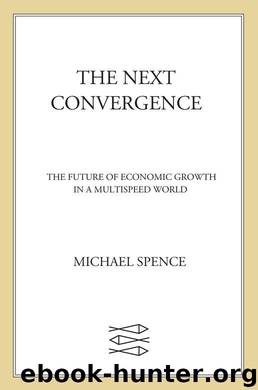The Next Convergence: The Future of Economic Growth in a Multispeed World by Spence Michael

Author:Spence, Michael [Spence, Michael]
Language: eng
Format: epub
Publisher: Farrar, Straus and Giroux
Published: 2011-05-10T00:00:00+00:00
25. Rebalancing the Global Economy and Its Consequences for Growth
Let’s turn now to the need for rebalancing the global economy, especially on the demand side. Prior to the crisis, people pointed with some frequency to what were then referred to as “global imbalances.” U.S. household savings had declined to zero as a result of the run-up in asset prices (including housing). This is an understandable and rational response to increased wealth—spend a small part of the windfall each year. Of course, like everyone else, U.S. consumers mistakenly thought the gains in asset values were permanent. We now know that in some sense they weren’t real. But behavior is driven (in real time) by beliefs and not by whether they turn out to have been accurate.
With household savings close to zero, the overall savings in the United States amounted to less than investment. Rising federal deficits (after 2000) as a result of a variety of policies including reduced taxes and the Iraq War contributed to the savings deficit. The government was spending more than it took in, and households were spending all their disposable income. When savings fall short of investment, the difference is made up by foreign capital inflows—think of these inflows as other peoples’ savings outside their own country. This showed up as a U.S. trade deficit of growing size.1 If you consume and invest more than you produce, you have to buy the difference from other countries, which results in a trade deficit: because your output is your income, if you are spending more than your income, you have to “borrow” the difference (also from outside) to finance it. So the trade deficit equals the net capital inflows (which means borrowing from other countries), and, conversely, a trade surplus equals the net capital outflows (or the lending to other countries).2
So where did these U.S. net capital inflows (external borrowing) come from? They came from countries running trade surpluses, the Gulf states, oil producers, China, Japan, and much of Asia, and a few other countries like Germany—though much of Germany’s surplus was absorbed by deficits in other E.U. countries. The E.U. trade surpluses and deficits are never all that large.
When people looked at this situation, they thought it was peculiar and wondered if it was sustainable. Opinion was divided on the latter question. With hindsight, we know that we should have seen that the U.S. side was not sustainable because it was based on an asset bubble whose existence was largely the result of financial-sector disequilibrium. But that didn’t happen, because financial innovation was believed to have reduced risk in the system. The rising asset prices were not, for the most part, seen as a bubble.
The persistence of high consumption and low saving and high asset prices was made possible by the complementary excess savings outside the country in the surplus countries. After all, if a country, disconnected from the global economy, tries in vain to consume more than it produces, it experiences inflationary pressures in the real economy, as people try to bid for the product that is there.
Download
This site does not store any files on its server. We only index and link to content provided by other sites. Please contact the content providers to delete copyright contents if any and email us, we'll remove relevant links or contents immediately.
| Accounting | Economics |
| Exports & Imports | Foreign Exchange |
| Global Marketing | Globalization |
| Islamic Banking & Finance |
The Meaning of the Library by unknow(2504)
Six Billion Shoppers by Porter Erisman(2267)
Why Nations Fail: The Origins of Power, Prosperity, and Poverty by Daron Acemoglu & James Robinson(2235)
No Time to Say Goodbye(2057)
Red Notice by Bill Browder(2025)
The Economist [T6, 22 Thg9 2017] by The Economist(1890)
Currency Trading For Dummies by Brian Dolan(1878)
Thank You for Being Late by Thomas L. Friedman(1739)
Bitcoin: The Ultimate Guide to the World of Bitcoin, Bitcoin Mining, Bitcoin Investing, Blockchain Technology, Cryptocurrency (2nd Edition) by Ikuya Takashima(1664)
Amazon FBA: Amazon FBA Blackbook: Everything You Need To Know to Start Your Amazon Business Empire (Amazon Empire, FBA Mastery) by John Fisher(1541)
Coffee: From Bean to Barista by Robert W. Thurston(1488)
The Future Is Asian by Parag Khanna(1436)
The Great Economists by Linda Yueh(1432)
Pocket World in Figures 2018 by The Economist(1388)
How Money Got Free: Bitcoin and the Fight for the Future of Finance by Brian Patrick Eha(1385)
Grave New World by Stephen D. King(1383)
Capitalism Without Capital: The Rise of the Intangible Economy by Jonathan Haskel(1373)
The Sex Business by Economist(1344)
Cultural Intelligence by David C. Thomas(1263)
